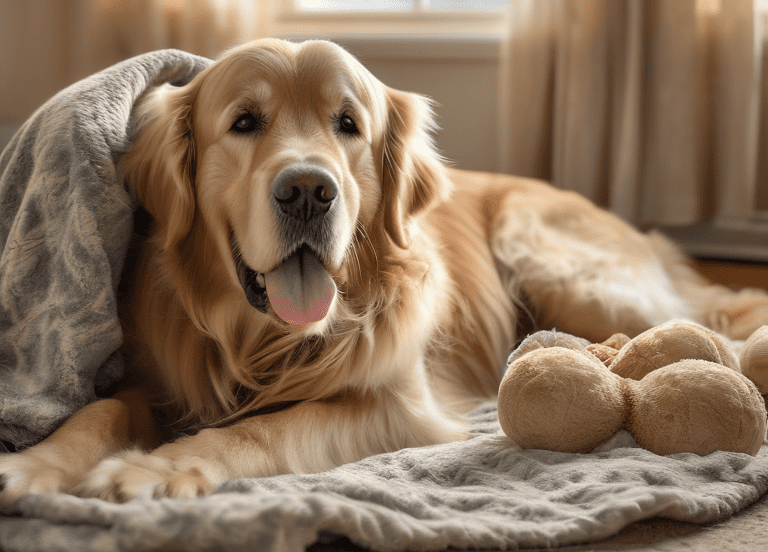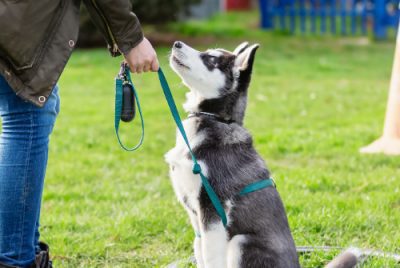Signs to Look for in an Aging Dog: Don’t Ignore These
Post Disclaimer
We may earn a commission for purchases made using our links. Please see our Disclaimer to learn more.
Uncover Signs to Look for in an Aging Dog
Key Highlights
- Dogs age faster than humans, and it’s important to monitor their health as they reach their senior years
- Common physical changes in aging dogs include vision and hearing loss, weight loss, and kidney disease
- Behavioral changes in senior dogs can be attributed to cognitive dysfunction and changes in their senior years
- Consult your vet when you notice unusual symptoms or need routine check-ups for your senior dog
- Adjusting your dog’s diet and providing supplements can help meet their dietary needs as they age
- Exercise and mobility are important for senior dogs, but it’s important to ensure they engage in safe exercise routines and provide mobility aids
- Mental health and cognitive function should be monitored in senior dogs, and enrichment activities can help maintain their cognitive health
- Creating a comfortable environment for aging dogs involves making home modifications and ensuring regular grooming
- End-of-life care should be considered, and knowing when it’s time to say goodbye and providing palliative care options are important aspects to consider
Introduction
As our beloved pets grow older, being more attentive to their health and well-being is crucial. Like us, dogs undergo physical and behavioral changes as they age. It’s vital for pet parents to notice these signs of aging so they can offer care and ensure their dog’s overall well-being. In this blog post, we’ll cover the indicators of aging in dogs, such as transformations, behavioral shifts, and the significance of vet checkups. We’ll also delve into requirements, exercise routines, mental wellness, living space creation, and end-of-life support for senior pups. Recognizing these signs and taking action can guide our companions through their golden years with comfort and joy.
Recognizing the Signs of Aging in Dogs
As dogs grow older, they experience changes in their behavioral patterns. It’s crucial for pet parents to recognize these indications to provide support. When a dog enters its stage, it might be classified as a dog. However, the aging process varies based on factors like breed and size. Older dogs may undergo transformations such as kidney problems, diminished eyesight, weight loss, and hearing impairment. Additionally, behavioral shifts like dementia can manifest in a dog’s years, highlighting the importance of managing these transitions. Pet owners can address health issues by observing aging symptoms in dogs –like reduced mobility, hearing loss, vision impairment, and cognitive decline. Adapt their furry companion’s care regimen for a happy and comfortable senior life.
Physical Changes and Health Indicators
As a dog’s age changes, their condition can be a marker of their well-being. Among dogs, kidney disease is a health concern. Warning signs may manifest as increased thirst, urination, and weight loss. Incontinence or difficulties with urination and defecation could also signal tract infections or kidney problems in dogs. Vision impairment occurs in aging canines, with cataracts and declining eyesight being issues. Weight loss may stem from causes such as problems, digestive issues, or underlying medical conditions. Moreover, hearing loss is common in dogs, emphasizing the need to be aware of their environment and adjust communication methods accordingly. Diarrhea is another health issue for dogs; it should not be dismissed as it might indicate an underlying problem that requires attention. These transformations all indicate advancing age and warrant consideration since they could signify health concerns requiring intervention.
- Kidney disease: Increased thirst, frequent urination, weight loss
- Vision loss: Cataracts, decline in eyesight
- Weight loss: Dental problems, digestive issues, underlying medical conditions
- Hearing loss: Be mindful of surroundings, adjust communication methods
Behavioral Changes in Senior Dogs
Behavioral changes are common in senior dogs and can be attributed to both cognitive dysfunction and the natural aging process. Dogs may exhibit confusion or disorientation, forget their name or commands, startle easily, become clumsier, experience changes in sleep patterns, show aggression or fear, develop anxiety, vocalize more, or have cloudy-looking eyes. These changes in a dog’s behavior are a normal part of aging. Still, if you notice any concerning symptoms or sudden changes, it’s important to consult with your veterinarian for further advice. Providing mental stimulation, maintaining a routine, and creating a safe and comfortable environment can help senior dogs navigate these behavioral changes and common causes and maintain their quality of life.
When to Consult Your Vet About Aging Signs
It’s crucial to take your dog for checkups at the vet. Aging can bring about some normal changes. It’s vital to seek professional advice if you observe any unusual symptoms or shifts in behavior in your older canine companion. These shifts might signal health issues that need attention, particularly if they impact how your dog acts and their overall well-being. Vets can offer guidance on managing health concerns and easing discomfort. Enhancing the quality of life for pets. Regular checkups also aid in catching and dealing with health problems early, boosting the likelihood of treatment and a longer, healthier life for your beloved furry buddy. If you spot any shifts like increased anxiety or loss of bladder control in your dog’s behavior, it’s crucial to see a vet to tackle these problems and prevent them from worsening. This becomes more crucial if your dog displays behavior problems that weren’t present during their younger years, as these could be linked to underlying health conditions.
Unusual Symptoms Not to Ignore
While a few signs and shifts in behavior might be expected as dogs grow older, there are symptoms that warrant attention, especially in older dogs. Cognitive dysfunction syndrome, which is sometimes referred to as dementia, can lead to confusion, disorientation, and changes in behavior. Hearing loss can affect a dog’s quality of life and communication ability. Furthermore, a weakened immune system in dogs can increase their vulnerability to infections and diseases like brain tumors. It is crucial to watch these signs and seek assistance to ensure the possible care for your aging canine companion.
- Cognitive dysfunction syndrome: Confusion, disorientation, changes in behavior
- Loss of hearing: Impact on quality of life and communication
- Weakened immune system: Increased susceptibility to infections and illnesses
Routine Check-Ups for Senior Dogs
Regular vet visits are essential for keeping dogs healthy and happy. At these appointments, a vet or vet tech will give your older pup a check-up, including weighing them and checking their heart rate and blood pressure. They might also run blood tests to check how their organs are doing and catch any health issues. These checkups allow you to discuss any worries or changes in your dog’s behavior or health. By staying on top of vet care, you can catch problems early. Ensure your furry friends enjoy a quality of life as they age gracefully. As parents, we prioritize our dogs’ well-being and make decisions in their best interests.
Dietary Needs for an Aging Dog
As dogs get older, their dietary requirements may shift. Addressing these changes is crucial to ensure they get the nutrients for health. For instance, senior dogs dealing with kidney issues might need a diet that’s low in protein. Keeping an eye on weight loss in aging dogs is important, so tweaking their food to include calories and nutrients can help them maintain a weight and body condition. Changes in appetite and metabolism could also happen, leading to adjustments in meal sizes and feeding times. Seeking advice from a vet and considering the age of dog food and supplements can go a long way in meeting the nutritional needs of your aging canine companion.
Adjusting Your Dog’s Diet with Age
As dogs get older, their dietary requirements change. It’s crucial to adjust their food intake to keep them at a weight and maintain muscle mass. Senior dogs might need a diet lower in calories to prevent weight gain due to their metabolism. However it’s important to ensure they still get the nutrients for health. Providing dog food tailored for dogs can help fulfill their nutritional needs. Furthermore, incorporating supplements like glucosamine for health and omega-3 fatty acids for health benefits can promote their general well-being. Seeking advice, from a vet can assist in determining the diet regimen for your aging dog and ensuring they get the nutrients they need to thrive.
Supplements for Senior Dogs
As dogs age, their immune system may weaken, making them more prone to infections and illnesses. Supplements like antioxidants and vitamins can help boost their system and maintain their health. Joint health is also a concern for aging dogs, so supplements with glucosamine and chondroitin can support their function and mobility. Older dogs may develop lipomas and fatty tumors that could benefit from supplements promoting healthy cell function. It’s always best to consult with a veterinarian before adding supplements to your dog’s diet to ensure they are safe and suitable for their requirements.
Exercise and Mobility for Senior Dogs
Physical activity and movement are vital for the health and happiness of dogs. While their energy may dwindle as they age, keeping them active is crucial to ward off muscle loss and joint issues. However, it’s just as important to ensure their exercise routines cater to their needs as they age. Regular physical activity can help control weight, enhance muscle strength, and promote well-being. Taking strolls, swimming sessions, and engaging in low-impact exercises are choices for senior furry companions. Monitoring their comfort levels during workouts and adjusting accordingly is key to preventing discomfort or injuries.
Safe Exercise Routines
Safety should be the top priority when it comes to keeping dogs healthy. Customizing their exercise regimens is essential based on their requirements and limitations. For dogs with arthritis, incorporating activities like swimming or leisurely strolls on soft terrain can be beneficial in avoiding strain on their joints. Regular physical activity plays a role in preserving muscle mass and promoting weight, but it’s crucial to steer clear of excessive exertion or strain. Monitoring your dog’s comfort level during exercise is key, and adjusting the intensity or duration of their workouts as necessary can help prevent any injuries. Seeking advice from a veterinarian can offer insights into crafting tailored exercise plans that cater to your senior dog’s specific needs.
Mobility Aids and Comfort Measures
For senior dogs with mobility issues or arthritis, there are various mobility aids and comfort measures that can improve their quality of life. Ramps or steps can help them access higher surfaces like cars or furniture easily. Providing a comfortable and supportive bed or crate can help alleviate joint pressure and provide a safe space for rest. In addition, it is important to consult with your dog’s veterinarian for suggestions of supplements and medications that can potentially help with the discomfort of arthritis. Orthopedic beds or memory foam mattresses can provide additional comfort and support for aging joints. It is important to create a safe and comfortable environment for your senior dog to navigate their surroundings without undue strain or discomfort. The following table summarizes some common mobility aids and comfort measures for senior dogs:
| Mobility Aids and Comfort Measures |
| Ramps or steps for easier access |
| Comfortable and supportive bed or crate |
| Orthopedic beds or memory foam mattresses |
| Non-slip mats to prevent falls |
| Elevated food and water bowls for easier access |
Mental Health and Cognitive Function
As dogs age, it’s essential to consider their well-being and brain function. Like humans, senior dogs can experience issues that resemble dementia. This might cause them to act differently, feel confused, or be disoriented. By noticing signs of decline in dogs, like forgetfulness or changes in their sleeping habits, pet owners can offer the right care and activities to keep them mentally stimulated. Cognitive dysfunction syndrome is an issue among dogs, but providing a lively and interactive environment can help preserve their mental sharpness and overall happiness.
Recognizing Signs of Cognitive Decline
As dogs age, they may experience decline, which is similar to dementia in humans. It’s essential for pet parents to be aware of the signs of dysfunction referred to as canine dysfunction (CCD) in their older canine companions. Common indicators include memory lapses, changes in sleeping habits, confusion, and alterations in behavior. Senior dogs might display signs of confusion, increased restlessness or anxiety, or decreased function. Recognizing these signs can help pet owners offer stimulation and engaging activities to support their aging dogs’ brain health. Establishing a routine and providing a comforting environment can also ease any anxiety or disorientation linked to decline.
Enrichment Activities for Cognitive Health
Keeping dogs sharp is important by engaging them in activities like puzzle toys, interactive games, and training sessions. Customizing these activities to suit your dog’s abilities and likes is key. Regular exercise, socialization, and a comfortable environment can boost their well-being. Managing separation anxiety and ensuring a soothing atmosphere can reduce stress. Enhance the health of senior dogs. Including these enriching activities in their routine can help them stay alert and lead a fulfilling life.
Creating a Comfortable Environment for Aging Dogs
Ensuring aging dogs have a living space is crucial for their well-being. Small changes at home can greatly improve their comfort and quality of life. Providing comfortable resting spots can relieve joint pressure and offer a peaceful retreat. Nonslip mats can prevent slips. Give support to dogs with mobility challenges. Adjusting the height of food and water bowls can make mealtimes easier for pets. Also, reducing noise and creating a tranquil environment can help ease anxiety and encourage relaxation. Pet parents can guarantee that their senior dogs feel at ease, protected, and content in their environment by making these adjustments.
Home Modifications for Senior Dogs
Improving the living conditions for dogs at home can make a difference in their comfort and safety. Installing ramps or steps can help them reach places like cars or furniture easily. Using slip mats on slippery surfaces can prevent accidents, especially for dogs with mobility challenges. Adjusting the height of their food and water bowls can make mealtime more enjoyable. Lessen strain on their joints. Providing a crate or bed gives them a snug spot to relax. It’s crucial to create an environment that meets the needs of dogs, ensuring they feel comfortable and supported as they go about their daily routines.
The Importance of Regular Grooming
Taking care of dogs involves grooming to maintain their health and happiness. During grooming sessions, it’s essential to check their skin, fur, and overall well-being for any bumps. As dogs age, their skin becomes more delicate and prone to dryness or irritation. Brushing them regularly helps prevent tangles and keeps their coat healthy. Dental care is crucial, too, since dental issues can impact dogs’ health. Grooming should also cover nail trimming, ear cleaning, and overall health assessments. Pet owners can maintain a routine to ensure their senior dogs stay comfortable and clean, enhancing their appearance and well-being.
End-of-Life Care
End-of-life care is an aspect to consider for dogs. When our beloved furry companions enter their years, it becomes vital to focus on maintaining their well-being and offering a level of care during this phase. Recognizing the time to bid farewell and exploring options for care can pose challenges, yet they are decisions that must be made. Conducting assessments on their quality of life, seeking advice from veterinarians, and engaging in conversations with owners can serve as valuable guidance in navigating these choices. Creating an affectionate setting addressing pain management needs and providing comfort is fundamental to ensuring a dignified end-of-life experience for our cherished senior dogs.
Knowing When It’s Time
It can be challenging for owners to determine when it’s the moment to bid farewell to an aging dog they cherish. Evaluating the dog’s quality of life plays a role in making such a decision. Owners need to consider aspects like managing pain, dealing with mobility issues, changes in appetite, and overall contentment. Seeking advice from a vet can offer support during this period. Maintaining the dog’s well-being and ensuring their final days are comfortable and loved are priorities. Although losing a dog is heart-wrenching, some owners may opt to bring a furry friend into their lives, bringing joy and companionship to themselves and the new addition.
Palliative Care Options
Caring for dogs in their years ensures they feel comfortable and loved. Palliative care is designed to focus on keeping these pups happy and pain-free. It involves methods like pain relief, therapy, proper nutrition, and emotional support for the dog and their humans. Seeking advice from a vet specializing in care can guide parents through this difficult period, ensuring their furry friend gets the care and attention they deserve. Through care, pet owners can provide comfort and companionship to their dogs during their final days.
Conclusion
In conclusion, recognizing and addressing the signs of aging in your dog is crucial for their overall well-being and quality of life. From physical changes to mental health and cognitive function, understanding and adapting to your senior dog’s needs is essential. Regular veterinary check-ups, appropriate diet adjustments, tailored exercise routines, and creating a comfortable environment are key aspects of caring for an aging pet. Remember, your furry companion has been by your side through thick and thin, so returning that love and care during their golden years is a rewarding responsibility.
Frequently Asked Questions
How often should a senior dog see a vet?
Senior dogs should see a veterinarian for routine check-ups at least twice a year. These check-ups help detect any underlying health problems early on and allow for prompt treatment. Regular veterinary visits are crucial for maintaining the health and well-being of senior dogs.
What are the signs that my dog is in pain?
Signs that your dog may be in pain include vocalization (whining or whimpering), restlessness, behavior changes (aggression or withdrawal), decreased appetite, and changes in mobility. It’s important to consult a veterinarian if you suspect your dog is in pain for appropriate diagnosis and treatment.
Can a dog’s diet affect its aging process?
Yes, a dog’s diet can affect its aging process. Proper nutrition is important for overall health and can help slow aging. Age-appropriate diets that meet the specific dietary needs of senior dogs can support their metabolism, promote a healthy weight, and contribute to their overall well-being.
How can I make my home more senior-dog-friendly?
Consider installing ramps or steps to help with mobility issues and make your home more senior-dog-friendly. Provide comfortable and supportive bedding and non-slip mats on slippery surfaces, and adjust the height of food and water bowls for easy access. These modifications can enhance the comfort and safety of your senior dog.






